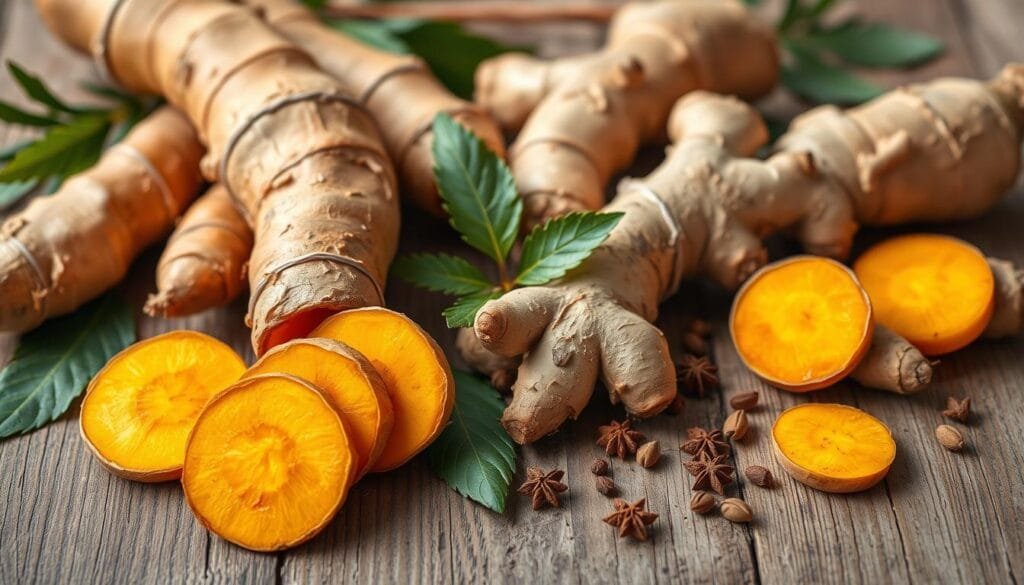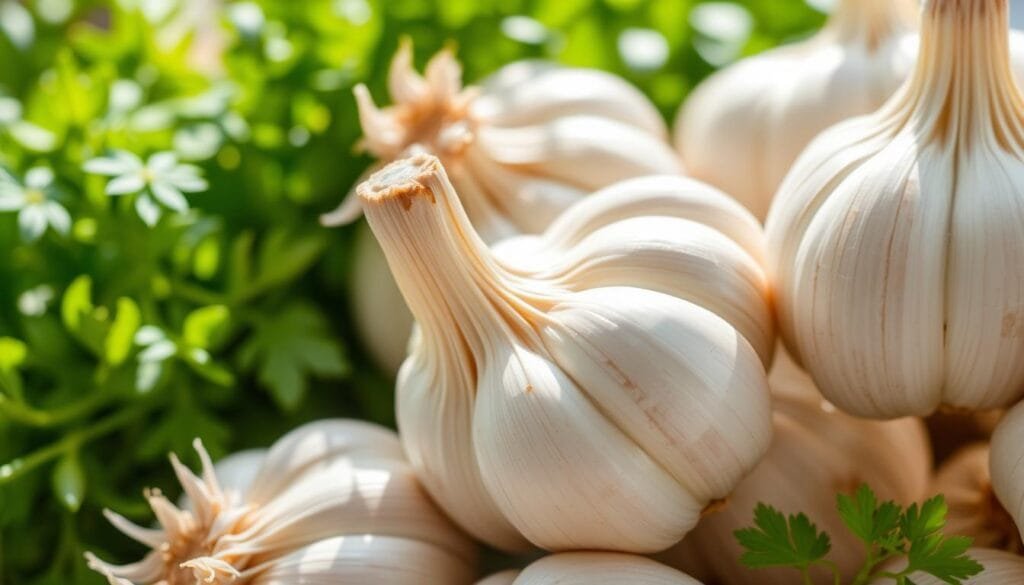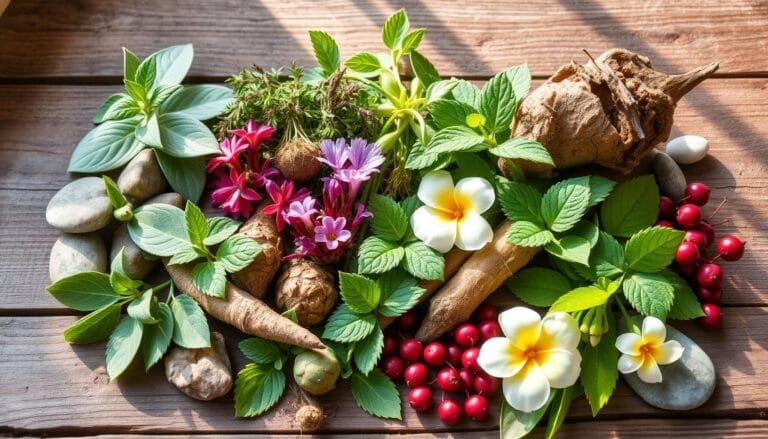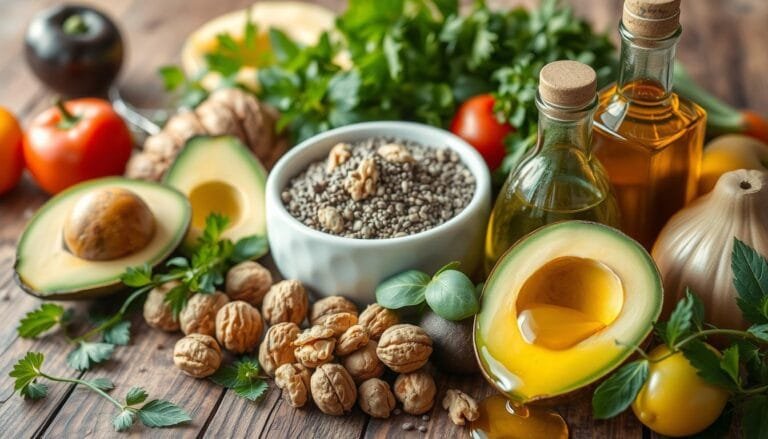The world of medicinal plants, also known as healing herbs, is full of natural remedies. These plants have been used for centuries to help with many health issues. They can reduce stress, ease anxiety, and help with inflammation and nausea.
As someone who believes in natural healing, I’m excited to share the top herbal remedies. These can improve our quality of life. They use the power of medicinal plants.
Herbs like ashwagandha, chamomile, echinacea, garlic, turmeric, and ginger are well-known for their healing properties. They contain special oils and compounds that help them work. This makes them great for natural healing and alternative medicine.
By learning about these herbs, we can use them to support our health. In the next sections, we’ll explore more about medicinal plants. We’ll look at their traditional uses, modern uses, and how they’re regulated for safety. Let’s discover the natural way to better health together.
Understanding the Power of Medicinal Herbs in Modern Healthcare
Herbal medicine has been a key part of healthcare for thousands of years. It’s used all over the world. In the U.S., the FDA treats herbal supplements differently than prescription drugs. This affects their safety and how well they work.
It’s important to know about FDA rules and quality when picking herbal supplements. This helps us understand their role in today’s health care.
Traditional Uses vs Modern Applications
For centuries, traditional medicine systems like TCM, Ayurveda, and Unani have used natural remedies. In Africa, India, and China, many people rely on traditional medicine. In the U.S., 38% of adults and 12% of kids used traditional medicine in 2007.
Herbal therapy was the most used alternative medicine at 18.9%.
FDA Regulations and Safety Guidelines
In the U.S., herbal supplements are seen as “foods” by the FDA. They don’t go through the same tests as medicines. This means their effectiveness isn’t always proven.
Herbal supplements also aren’t standardized like medicines. This can lead to differences in quality and strength between batches. It’s key to check the quality and safety of herbal supplements.
They can interact with other medicines and have side effects. Always talk to a healthcare provider before using them.
Quality Considerations for Herbal Supplements
Choosing good herbal supplements is important. Look for products from trusted makers and those that have been tested independently. Some companies might add cheap fillers, which can lower the quality.
Even natural things can be unsafe. Always talk to a healthcare provider before using any herbs or supplements. This way, you can use herbal medicine safely and effectively for your health.
Top Herbal Remedies for Common Ailments
Herbal remedies have been used for centuries to address many health issues. They offer a gentler alternative to conventional medications. Let’s explore some top herbal remedies for various ailments.
Chamomile for Relaxation and Wound Healing
Chamomile is known for its calming and soothing properties. In the United States, it’s used to help with anxiety and relaxation. In Europe, it’s applied topically for its anti-inflammatory effects, useful for wound healing and reducing swelling.
Echinacea for Immune Support
Echinacea is known for boosting the immune system. It’s taken to prevent or reduce the severity of colds, flu, and other respiratory infections. Studies show it can enhance the body’s defenses and shorten cold symptoms.
Ginger for Nausea and Inflammation
Ginger is versatile in traditional medicine. It’s effective in alleviating nausea, including morning sickness and chemotherapy-induced nausea. It also has potent anti-inflammatory properties, useful for reducing pain and swelling.
Turmeric for Pain Relief
Turmeric contains curcumin, which has anti-inflammatory and pain-relieving properties. Research shows it can be as effective as some over-the-counter medications in reducing inflammation and managing pain.
These are just a few examples of herbal remedies for common health issues. Always consult with a healthcare professional before using these herbs. Proper dosage and safety guidelines are essential for safe and effective use.
| Herb | Common Uses | Key Compounds |
|---|---|---|
| Chamomile | Anxiety, relaxation, wound healing | Apigenin, luteolin |
| Echinacea | Immune support, cold and flu prevention | Alkylamides, polysaccharides |
| Ginger | Nausea, inflammation, pain relief | Gingerol, shogaol |
| Turmeric | Pain relief, inflammation | Curcumin |
Remember, while these natural remedies can be beneficial, always consult with a healthcare professional. This is true if you have any underlying conditions or are taking other medications. Adding herbal treatments to your wellness routine can be safe and effective.
Ashwagandha: The Ancient Stress-Fighting Adaptogen
Ashwagandha comes from the Withania somnifera plant and is key in Ayurvedic medicine. It’s known for helping the body deal with stress. This is very helpful in today’s busy world.
Benefits for Stress and Anxiety
Many studies show ashwagandha lowers cortisol, the main stress hormone. In one study, people who took 250 mg or 600 mg of ashwagandha daily for 8 weeks felt less stressed and had lower cortisol levels than those who took a placebo.
Ashwagandha also calms the mind and helps with anxiety. A study found that taking 240 mg of ashwagandha daily for 60 days greatly reduced anxiety in participants.
Proper Dosage and Consumption Methods
The right dose of ashwagandha is important. Studies say 250 mg to 600 mg daily, split into two doses, is best. It’s best to take it 30 minutes before meals. You can find ashwagandha in capsules, tinctures, and powders, making it easy to use.
Potential Side Effects and Interactions
Ashwagandha is usually safe but can make some people feel drowsy. It’s not good to take during pregnancy or breastfeeding. Also, people on certain medicines should talk to their doctor before using ashwagandha.

“Ashwagandha has been used in Ayurvedic medicine for thousands of years to help the body cope with stress and anxiety.”
Chamomile: Nature’s Calming Agent
Chamomile is a well-loved herb known for its calming effects. It’s a popular choice for those looking for natural ways to ease anxiety and improve sleep. You can enjoy it as a herbal tea, use it as a calming compress, or apply it to the skin for irritation.
German chamomile (Matricaria recutita) is the more potent type and is widely used for its health benefits. A recent study found that chamomile significantly reduced anxiety symptoms in people with Generalized Anxiety Disorder (GAD). The study aims to continue this research for five years to ensure its safety and effectiveness.
Chamomile’s calming effects come from compounds like apigenin. These compounds may help decrease anxiety and promote relaxation. Chamomile also has antioxidant, antimicrobial, antidepressant, anti-inflammatory, antidiabetic, and antidiarrheal properties, making it a great ally for overall health.
While chamomile is generally safe for short-term use, it can cause allergic reactions in some. It may also interact with blood thinners and certain medications. Always talk to a healthcare professional before adding chamomile to your routine.
“Chamomile (Matricaria recutita) is one of the most widely used herbal remedies globally and is included in the pharmacopoeia of 26 countries.”
In conclusion, chamomile is a great choice for those looking for a sleep aid, anti-inflammatory solution, or a way to manage anxiety and stress. Enjoyed as a comforting herbal tea or applied topically, chamomile offers a safe and effective way to support well-being and promote tranquility.
Turmeric and Ginger: Powerful Anti-inflammatory Herbs
Turmeric and ginger are two strong herbal allies for natural pain relief. They have been used for centuries in traditional medicine. Modern science is now confirming their anti-inflammatory powers.
Scientific Evidence for Pain Relief
Curcumin, found in turmeric, shows great promise in treating pain, mainly from inflammation. Research indicates it can be as effective as some anti-inflammatory drugs. Ginger, with its anti-inflammatory and antioxidant properties, is also great for pain and nausea.
Recommended Forms and Dosages
A daily dose of 500 mg of curcumin from turmeric can help with pain. You can eat ginger fresh, as tea, or take it as a supplement. To better absorb turmeric, add black pepper or healthy fats to your meal.
Ways to Enhance Absorption
- Combine turmeric with black pepper, which contains piperine that can increase curcumin absorption by up to 2,000%.
- Consume turmeric with healthy fats, such as coconut oil or avocado, to further enhance bioavailability.
- Consider taking turmeric in a liposomal or phytosome form, which can also improve absorption.
Adding these anti-inflammatory herbs to your daily routine can help manage pain naturally. Always talk to a healthcare professional before starting any new herbal treatment.

Echinacea: Boosting Immune System Function
Echinacea is a favorite herb in America, used for over 400 years. It’s a flowering plant in the daisy family. People use it to help their immune system and fight off colds and flu.
Echinacea has compounds that might help with inflammation, viruses, and antioxidants. It’s a top pick for those looking for natural immune support and cold prevention. Research shows it could lower the chance of getting sick by 22% and shorten colds by 1-4 days.
- Echinacea comes in extracts, tinctures, tablets, capsules, and teas.
- It’s best to take echinacea with food to avoid stomach issues.
- The three main types used for medicine are Echinacea angustifolia, Echinacea pallida, and Echinacea purpurea.
Echinacea might act as a natural antibiotic, but the proof is not clear. Some studies show no real benefits, and long-term use could harm the immune system or liver. People with certain health issues or taking certain meds should talk to their doctor before using echinacea.
“Echinacea is one of the top 10 herbal supplements in the U.S., indicating its popularity among consumers.”
Choosing a good echinacea supplement is key. A ConsumerLab.com study found only 4 out of 11 products matched their labels. With the right research and doctor advice, echinacea can help boost your immune system and fight off common illnesses.
Garlic: The Natural Antibiotic and Heart Health Protector
Garlic has been used for thousands of years for its health benefits. It’s full of compounds that help our health in many ways. Garlic fights infections and keeps our hearts healthy, making it a key part of our wellness.
Cardiovascular Benefits
Garlic is great for our hearts. Studies show it can lower blood pressure and bad cholesterol. It may even cut the risk of heart attack and stroke by up to 40%.
The sulfur in garlic helps our blood flow better and reduces stress in our bodies.
Antimicrobial Properties
Garlic is known for fighting off many kinds of germs. Its compounds, like allicin, can stop bacteria, viruses, and fungi. Some studies say garlic is as good as antibiotics in fighting infections.
Fresh vs Supplement Forms
You can eat garlic fresh or take it as a supplement. Fresh garlic is full of good stuff, but supplements like aged garlic extract offer more in a convenient form. The right amount is 2-5 grams of fresh garlic or 2,400 milligrams of liquid extract daily.
Adding garlic to your diet or supplements can boost your health. It’s a simple way to support your body’s natural defenses and heart health. Let garlic’s power work for you.

“Garlic is an amazing natural remedy with a wide range of health benefits. From fighting infections to supporting cardiovascular function, it’s a true superstar in the world of herbal medicine.”
Essential Herbs for Digestive Health and Nausea Relief
Keeping your digestive system healthy is key to feeling good. Nature has many herbs that can help with digestion and nausea. Let’s look at some of the best herbs for these issues.
Ginger is amazing for soothing upset stomachs and easing nausea. It works well for morning sickness or nausea from chemotherapy. Ginger’s compounds relax the digestive tract and reduce inflammation.
Peppermint is also great for digestion. Research shows it can ease irritable bowel syndrome (IBS) by relaxing the colon and fighting bad gut bacteria. Peppermint’s menthol helps soothe stomach pain and diarrhea.
Chamomile is a gentle but powerful herb for digestion and nausea. Chamomile tea can calm your digestive system and improve your overall health.
Fenugreek seeds are also good for digestion. They make a tea that can help with diarrhea because of their fiber. This helps keep bowel movements regular.
Remember, while these herbs are helpful, use them right and know their side effects. Always talk to a healthcare professional before trying new herbal remedies.

“Maintaining a diet rich in plants and herbs can rapidly improve gut health according to research.”
Adding these natural digestive aids and nausea relievers to your life can help your digestive health. They can also ease common stomach problems.
Safe Integration of Herbal Remedies into Daily Wellness Routine
Starting my journey to holistic wellness means adding herbal remedies to my daily life. I always talk to my healthcare providers before trying new herbs, if I’m on other meds. It’s important to pick high-quality, pure herbal supplements.
Herbs like turmeric and ginger are easy to add to my meals. I use them in teas, smoothies, or cooking. For stress or immune support, I might take ashwagandha or echinacea as supplements. I always follow the dosage and watch for any side effects.
Adding herbal remedies to my routine is about finding balance. I mix these natural practices with a healthy lifestyle, good food, and exercise. This way, I use herbal remedies safely and effectively in my daily life.







